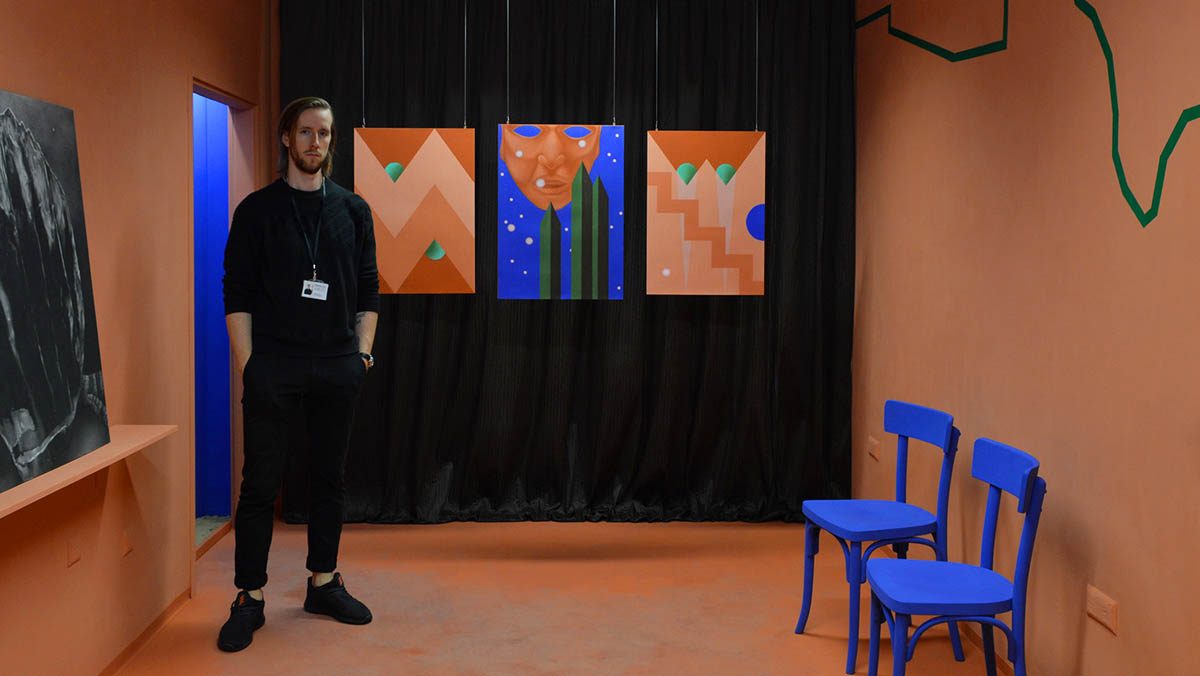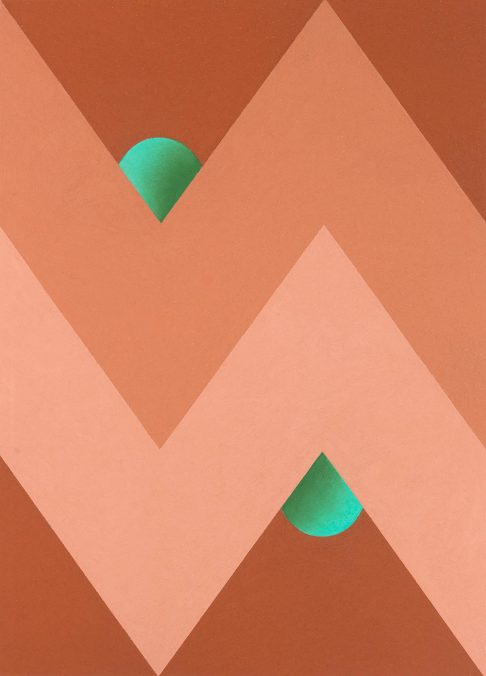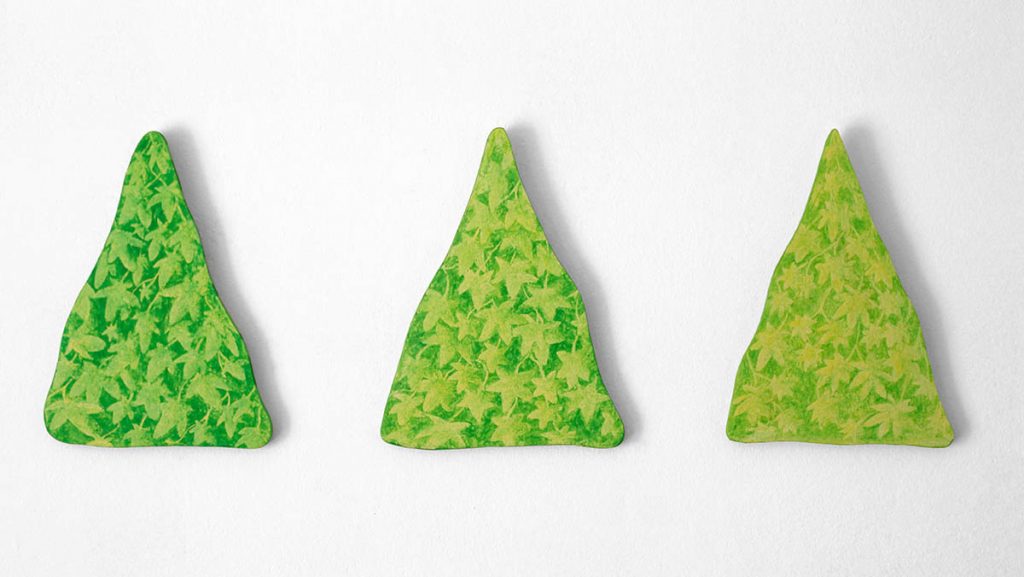LEGAL ALIENS is an exhibition that deals with meteorites, migration, the US/Mexico border, and modernist architecture. In a narrative combined of these various elements, color, form, and imagery tell a story about science, politics, and creating utopias or dystopias.
The title of this body of work refers to cosmic migrants (meteorites) as „Legal Aliens“, a play on the rather derogatory term „illegal alien“ that is often used by the media to describe individuals who have unlawfully crossed a border. As meteorites are named and associated with the geographical location, in which they land, they are basically assigned a national identity, although they originate from a place that is incredibly distant from our planet.

The exhibition included two large charcoal drawings of Mexican Meteorites and four pastel compositions, created with the palette of Mexican architect Luis Barragan in mind. In addition, a line in green representing the border wall between the United States and Mexico cut its way along one side of the space.
The two meteorites depicted are Mexican Meteorites (Coahuila and Acuña) from the collection of the Naturhistorisches Museum Wien, which has the largest collection of meteorites on display in the world. The first of these, Where Serpents Creep, (Coahuila) is a nocturnal depiction where the tail and rattle of a rattlesnake is visible. Faint stars are scattered in the sky – the image is calm and serene, yet also foreboding. The second Meteorite drawing, Amistad, (Acuña), is depicted in the midday sun, suspended in front of what is discernible as the wall of a dam. This image references the US/Mexican project of the 1960’s which was festively dedicated in 1969 in the presence of US president Richard Nixon and Mexican president Gustavo Diaz Ordaz. There are many layers to these images, including subtle references to history and the history of the border area, with a certain unease persisting throughout.
Pedregal Composition I 2020 Soft Pastel on Paper 72 x 52 cm
The pastel works in contrast to the charcoal drawings are very colourful and simple compositions. Their graphic quality makes reference not only to Mexican Modernism and Modernism in general, but most of all they are inspired by the Architecture of Luis Barragan, especially the Casa Pedregal, which is built on a lava field near Mexico City. The garden of the Casa Pedregal itself is strewn with volcanic stone, giving it an otherworldly almost alien quality. Barragan, especially through his famed Torres de Satelite in Mexico city sought to create a connection between our earth and the cosmos, and one of my pastel works (Towers/Torres) makes specific reference to this. Next to the simple compositions, a face, reminiscent of an Aztec mask shows up in two of the works, floating like the face of a god in the sky. Suspended with this face are also lights or orbs, though if they represent stars, satellites, or perhaps drones, I will not specify. A great deal of what is considered border security is in fact an enormous amount of surveillance – this ranges from the aforementioned drones to inferred cameras, or game cameras, towers, satellite surveillance, and even blimps as well as others.
The main themes in my work have been identity, or identity building, nature, science, and history – always in terms of how that history directly relates to issues of the present.

The scientific sphere is more or less the sphere of the natural world, therein lie many things, including meteorites. I grew up in a very remote region in California, near Yosemite National Park, and the natural world is something I am able to speak about in a very real way. Drawing for me is making sense of the world – we draw and sketch to plan and process our surroundings and the issues we are confronted with. That is exactly the purpose of drawing for me – and in a very intense way, as the drawing I do is extremely intricate, obsessive and detailed.
Florian Raditsch (b. 1987) is an artist born and raised in central California. Having grown up in the foothills of the Sierra Nevada mountains near Yosemite National Park and its singular monumental formations, the landscapes of California and the Southwest, both physically, and in sociopolitical terms have had a lasting impact on the artist and his work. Confronted at an early age with the photography of Ansel Adams, Raditsch whose family emigrated to the US from Austria, grew up with the visual influences of his childhood surroundings as well those of the old world. After studying Fine Arts at the University of Art and Design in the high desert of Santa Fe, New Mexico, Florian Raditsch graduated from the class of Prof. Judith Eisler at the University of Applied Arts in Vienna in 2015. Raditsch works in many mediums, most notably with charcoal, creating charcoal drawings in a highly unique and deliberate technique. Much of Raditsch’s works center around the theme of identity as well as many sociopolitical issues, such as the subject of the US/Mexico border. Notable exhibitions include Legal Aliens at the Instituto Cultural de Mexico in Vienna, Ticket to the Moon at the Kunsthalle Krems, Our Moon. Longing, Art and Science at the Naturhistorisches Museum Wien and Stars – Cosmic Art from 1900 up to the Present at the Lentos Art Museum. In September 2021, Florian Raditsch’s solo exhibition The False Faces opens at the Tyrolean State Museum in Austria.
Florian Raditsch – www.florianraditsch.com









